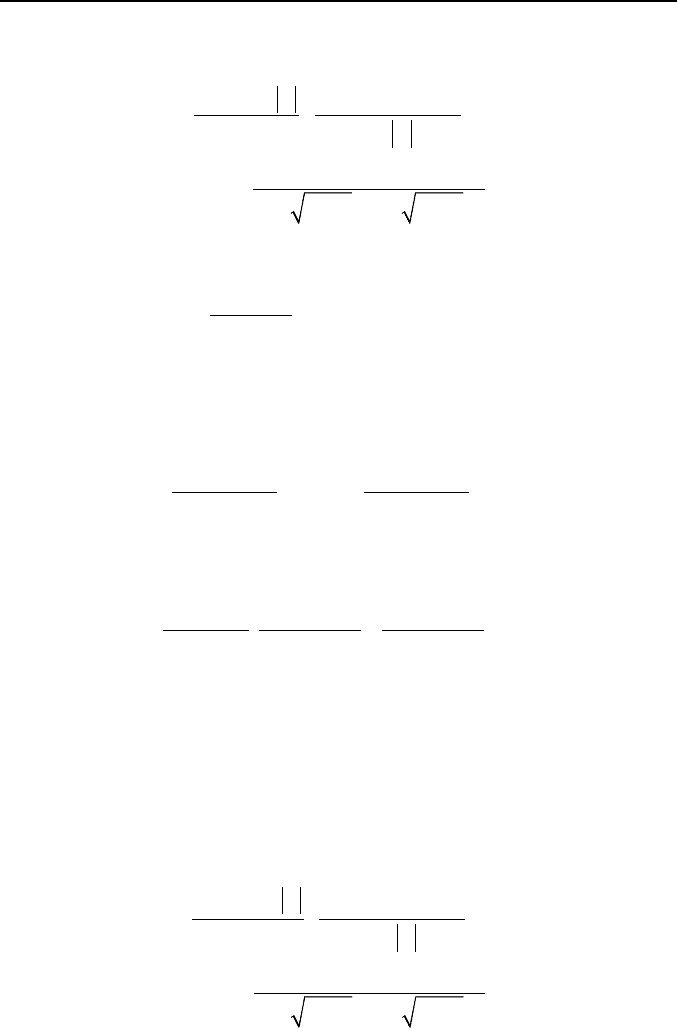Gross R., Sidorenko A., Tagirov L. Nanoscale Devices - Fundamentals and Applications
Подождите немного. Документ загружается.


262 S. L. Prischepa
integral surface effects in multilayers. Theoretical work is in progress in
order to get a deeper insight into the problem.
Conclusion
In conclusion, we have performed a systematic study of the influence of the
finite dimensions of the S/N proximity coupled multilayers on the H-T
phase diagram and angular dependences of the upper critical magnetic field.
Our experiments were performed with two different systems, namely
Nb/Cu and Nb/Pd, with different ratios between d
S
and d
N
and different N
b
values (i.e. symmetry of the samples). The observed H
c2||
(T) dependences
differ with respect to the position of the geometrical symmetry plane. For
samples with the symmetry plane located in the middle of the N layer the
measured H
c2||
(T) curves were typical for S/N multilayers, presenting the
well known 3D-2D crossover at a certain T*<T
c
. For samples with the
symmetry plane in the middle of S layer the H
c2||
values were higher in the
region T→T
c
, revealing the characteristic features of 2D behavior up to T
c
.
The systematic study of the angular dependences reveal that for samples
with central S layer the H
c2
(Θ) curves always show the 2D-like behavior in
agreement with the H
c2||
(T) results. At the same time for samples with the
symmetry plane in N layer the H
c2
(Θ) behavior was more complicated,
most likely due to the influence of a complex interface effect on the spatial
distribution of the superconducting wave function.
Acknowledgments
This work has been partially supported by the national Program
"Nanoelectronics" under the grant 01-3109. Valuable discussions with
V.N. Kushnir and C. Attanasio are gratefully acknowledged. The
experimental work has been done with assistance of C. Cirillo and
M. Salvato.
References
1. Abrikosov AA (1957). Sov Phys JETP 32:1442
2. Saint-James D, De Gennes PG (1963). Phys Lett 7:306
3. Saint James D (1965). Phys Lett 16:218
4. Yamafuji K, Kusayanagi E, Irie F (1966). Phys Lett 21:11

Properties of S/N Multilayers with Different Geometrical Symmetry 263
5. Tinkham M (1963). Phys Rev 129:2413
Tinkham M (1964). Phys Lett 9:217
6. Fink H (1969). Phys Rev 177:732
7. Takahashi S, Tachiki M (1986). Phys Rev B 33:4620
8. Mineev VP (2001). Phys Rev B 65:012508
9. Koperdraad RTW, Lodder A (1996). Phys Rev B 54:515
10. Ciuhu C, Lodder A (2001). Phys Rev B 64:224526
11. Schuller IK (1980). Phys Rev Lett 44:1597
12. Chun CS, Zheng G-G, Vicent JL, Schuller IK (1984). Phys Rev B 29:4915
13. Nieuwenhuys GJ (1975). Adv Phys 24:515
14. Cirillo C, Prischepa SL, Salvato M, Attanasio C (2004). Eur Phys J B 38:59
15. Cirillo C, Attanasio C, Maritato L, Mercaldo LV, Prischepa SL, Salvato M
(2003). J Low Temp Phys 130:509
16. Lawrence WE, Doniach S (1970). Proc LT-12:361
17. Kushnir VN, Prischepa SL, Della Rocca ML, Salvato M, Attanasio C (2003).
Phys Rev B 68:212505
18. Kushnir VN, Prischepa SL, Cirillo C, Della Rocca ML, Armenio A,
Maritato L, Salvato M, Attanasio C (2004). Eur Phys J B 38:59
19. Jin BY, Ketterson JB, NcNiff EJ, Foner S, Schuller IK (1987). J Low Temp
Phys 69:39
Andreev Reflection in Ballistic Superconductor-
Ferromagnet Contacts
L. R. Tagirov
1,2
, B. P. Vodopyanov
2
1
Kazan State University, 420008, Kazan, Russia
2
Kazan Physico-Technical Institute of RAS, 420029 Kazan, Russia
Abstract: On the basis of Eilenberger-type equations of superconductivity for
metals with exchange-split conduction band we derive an original
expression for the Andreev conductance of superconductor-
ferromagnet point contacts. We give particular formulas for different
relations between Fermi momenta of contacting metals, and calculate
the Andreev conductance as a function of exchange splitting of the
ferromagnet conduction band. From comparison with experimental
data on point contact Andreev reflection spectroscopy we estimate
the conduction band spin polarization for a series of ferromagnets in
contact with superconductors.
Keywords: Quasi-classical theory of superconductivity, Andreev reflection,
ferromagnet-superconductor point contacts
Introduction
At low temperatures, an electric current from a normal metal enters
through a contact in a superconductor by means of Andreev reflection [1].
In the process of Andreev reflection an electron coming to the normal
metal/superconductor interface is reflected back into the normal metal as a
hole with the opposite spin, and the formed Cooper pair moves through the
superconductor transferring a charge
2e . This results in doubling of the
differential conductance of a pure N/S nanocontact which has been
demonstrated theoretically in Ref. [2] (BTK) based on the solution of the
Bogoliubov equations. In Ref. [3] it was emphasized that the Andreev
265
R. Gross et al. (eds.), Nanoscale Devices - Fundamentals and Applications, 265–275.
© 2006 Springer. Printed in the Netherlands.

266 L. R. Tagirov, B. P. Vodopyanov
reflection in ferromagnet/superconductor (F/S) contacts is suppressed as the
spin polarization of the ferromagnet conduction band sets up. The general
understanding of this suppression is by a reduction of the efficiency of the
Andreev reflection process associated with the decrease of the number of
conducting channels in the minority spin-subband (the subband with the
lower value of the Fermi momentum). It has been proposed to use the
suppression of Andreev reflection in F/S contacts to determine the spin
polarization of the conduction band of ferromagnets (Andreev spectroscopy
of ferromagnets) [4-9]. Experimental data were interpreted on a
phenomenological basis [4, 5, 7]. The BTK theory was generalized and
applied to F/S point contacts in the theoretical works [8-13]. However, the
general requirement that the Fermi momenta of contacting ferromagnetic
and superconducting metals are not the same has not been taken into
account. The number of experiments on Andreev spectroscopy of diverse
ferromagnets grows [14-20], what demands an adequate theoretical
description. In this paper we derive particular formulas for the Andreev
conductance of a superconductor in a point contact with different types of
ferromagnets. From comparison with experiments on Andreev spectroscopy
we estimate the polarizations of the conduction bands of ferromagnetic
metals.
Equations of Superconductivity and General Boundary
Conditions for Superconductor-Ferromagnet Contacts
The equations for the equilibrium thermodynamic Green functions (GF)
read:
l ll l
11
11
ˆ
ˆˆˆˆ
ˆ
s
g
n( ) ( ) [ ] 0
ˆˆ
2
ˆ
ˆ
s
g
n( ) ( ) [ ] 0
ˆˆ
2
xj xj
xj
xj xj
xj
gggKg
p
vv
x
GGGKG
p
vv
x
ww
ww
ww
ww
v
ȡ
v
ȡ
&
&
(1)
The quantities which enter the above equation are defined as follows:
>@
11
22
ˆˆ
ˆ
ˆˆ
()()2
ˆˆˆˆ
xj xj x x
nz
xj xj
Kii i
pp
vv
a b ab ba
HW
WW
r
'6
r
(2)

Andreev Reflection in Ballistic Superconductor-Ferromagnet Contacts 267
11
22
2
2
ˆ
ˆ
() ()
ˆˆ
(2 )
F
F
xx
d
ic u
g
vv
S
_ _
6
³
p
&
(3)
2
11
ˆ
ˆ
2
S
S
S
SS
mp
icu
g
WW S
! _ _
6
(4)
where the functions
ˆ
g
and
l
G are the quasiclassical GF of incident and
reflected quasiparticles,
D
W
are the Pauli matrices,
D
is the spin index,
(2 1)
n
nT
HS
is the Matsubara frequency, ' is the order parameter,
F
p
D
is the Fermi momentum of the ferromagnet spin-subbands,
S
p is the Fermi
momentum of a superconductor,
u is the potential of interaction of
electrons and impurities,
c is the concentration of impurities,
S
W
is the
mean free time of electrons in a superconductor, and brackets mean
averaging over the solid angle:
/4d
S
! :
³
v
. Hereafter we use the unit
system in which
1c = , so that we do not distinguish momentum and
wave number, for example. We assume that the F/S interface coincides with
the plane 0x . Then, ()x r ȡ , and ()
y
z ȡ is the coordinate within the
contact plane,
1
ˆ
x
v the matrix of the Fermi velocities projections to the x
direction, and the other notations are standard.
The above Eilenberger-type equations for the metal with the exchange-
field-split conduction band had been derived for the first time in [21, 22].
They are valid for arbitrary band splitting and arbitrary spin-dependent
mean free paths within the quasiclassic approximation. The system of
Eqs. (1) must be supplemented with boundary conditions at the F/S
interface (see details in Refs. [22, 23]):
l
l
ˆˆ
SF
SF
aa
aa
dd
dd
gg
GG
(5)
12 34 34
12 34 12
ˆˆ ˆˆ ˆˆ
ˆˆˆˆ
ˆˆ ˆˆ ˆˆ
ˆˆˆˆ
aaa a
aaa a
gggg
bb bb bb
gggg
bb bb bb
(6)
The
ˆ
i
b matrices are given by

268 L. R. Tagirov, B. P. Vodopyanov
ll ll
ll ll
12
34
ˆˆ
ˆˆ ˆˆ
ˆˆ
ˆˆ ˆˆ
,
ss ss
ss ss
ss ss
ss ss
gg gg
bb
GG GG
gg gg
bb
GG GG
(7)
where
()
ˆ
sa
g
and
l
()sa
G are the matrices, which are symmetric (s) and
antisymmetric (a) with respect to the variable
j
x
p :
l ll
()
()
11
ˆˆˆ
22
sa
sa
ggg
GGG
!
!
r r
ª
º
ªº
¬¼
¬
¼
(8)
Note that only the diagonal part of the functions is continuous at the F/S
interface (Eq. (5)). These BCs take into account explicitly the spin-
dependence of F/S interface.
General Expression for the Andreev Conductance of F/S
Point Contacts
We start with the equation for the current I in the linear approximation
with respect to the electric field
(00)
x
E E . The current is calculated on
the ferromagnet side of the contact at
0xo :
2
22
111 1
1
lim
24cosh(2)
()() ( )
xz
RA
xz
ed
ITr
mxx T
dG E G
x
H
W
SH
HWH
c
f
§·
¨¸
¨¸
c
¨¸
o
©¹
f
c
ww
°
®
ww
°
¯
½
w
u
¾
w
¿
³
³
rr
rrrr rr
(9)
Here,
()RA
G is the retarded (advanced) GF, which is obtained from the
temperature dependent GFs, Eqs. (1), by substituting
i
HG
r for
n
i
H
. After a
Fourier transformation with respect to 'ȡȡ coordinate, we obtain the
ballistic conductance
FS
G
of the F/S point contact:
ll ll
`
2
2
2
16 cosh ( 2 )
2
ˆˆ ˆˆ
1
FS z
RA RA
RA RA
zz z z
ss aa
ss aa
d
Ae d
GTr
T
gg gg
GG GG
H
W
SH
S
WWW W
f
f
°
®
°
¯
ªº
u
¬¼
³
³
p
&
(10)

Andreev Reflection in Ballistic Superconductor-Ferromagnet Contacts 269
Now, we have to solve the first of Eqs. (1) with the BCs given by
Eqs. (5)-(7). When
ˆ
g
is independent of ȡ the solution to Eq. (1) takes the
form
ˆˆ
ˆˆ
sgn( ) sgn( )
ˆˆ
ˆ
()
jx jx
Kx Kx
pp
j
Fj j
j
eCe C
g
p
(11)
The matrices
ˆ
j
C represent the values of GF
ˆ
j
g
at large distances from the
F/S interface, and for the superconductor we have
2
2
2
1
ˆ
n
n
n
i
gf
C
i
fg
H
H
H
§·
¨¸
¨¸
¨¸
¨¸
©¹
'
§·
¨¸
'
©¹
'
(12)
In the ferromagnet
1
ˆ
g
must tend to
1
ˆ
s
g
n( )
zn
C
WH
at x of, and in the
superconductor
2
ˆ
g
must tend to
2
ˆ
C
at x of. Performing the matrix
multiplication in Eq. (11), we find that these conditions are fulfilled if the
following relationships are satisfied:
ˆˆ ˆ
ˆˆ
() () s
g
n( )( 1) ( )
j
F
j j Fj j jx j Fj
jj
CC p C
CC
pp p
(13)
From these relationships, it follows that
ˆˆˆ ˆ
ˆ
ˆ
(1)
j
j
jja ja
js
ja
CCC C
g
g
(14)
Passing in Eq. (14) to the functions
ˆ
s
g
r
, substituting them into the system
of BCs given by Eqs. (6), and solving the resulting equations in the linear
approximation with respect to
ˆˆˆ
12[ ]
SF
aaa
CCC
r
r , we find,
(1 )
ˆ
2[1 (1 ) ]
x
a
fRRDD
C
RR RR g
DD D D
DD DD
W
r
r
(15)
Now, from Eq. (10) and making use of Eqs. (5) and (15), we find the
Andreev conductance
A
G of the F/S point contact
2
2
0
2
22
22
(0)
4cosh(2)
4
2
(1 ) 4
AFS
d
GGV Ae
T
dDD
RR RR
H
SH
S
H
'
pn
pn pn
'
u
'
³
³
p
&
(16)

270 L. R. Tagirov, B. P. Vodopyanov
The experimental data [4-8] are given in the normalized form. The
normalization is, in fact, the conductance at high voltage, V>>ǻ, which is
equal to the conductance between a ferromagnet and a normal metal. This
conductance can be calculated as follows:
2
2
2
0
2
2
2
0
(0) sin(2)
8
sin(2 )
8
cr
cr
F
FN
F
Ae p
GV d D
Ae
p
dD
T
T
TT
S
TT
S
§·
¨¸
p
©¹
ppp
§·
¨¸
n
©¹
nnn
³
³
(17)
The equations (16), (17) are valid for an arbitrary transmission
coefficient
D
D
. They depend on the relationship between the Fermi
momenta of the ferromagnet spin-subbands
F
p
p
,
F
p
n
, and the Fermi
momentum of the superconductor,
S
p . Upon integration on the angles the
conservation of the component of the momentum parallel to the interface
plane must be obeyed:
sin sin sin ,
FFSS
pppp
TTT
__
ppnn
(18)
which determines the critical angle ș
cr
in equation (17).
Andreev Conductance for Various Relations Between
Fermi Momenta of Contacting Metals
We analyze three possible relations between the Fermi momenta of
contacting metals: 1)
SFF
ppp
pn
, 2)
F
SF
ppp
pn
, and finally, 3)
F
FS
ppp
pn
.
Case 1),
SFF
ppp
pn
:
The expression for
A
G takes the form:

Andreev Reflection in Ballistic Superconductor-Ferromagnet Contacts 271
2
2
1
(1)
2
2
0
/2
22
0
4
cosh / 2
sin(2 )
(1 ) 4
S
A
SS
Ae p
dx
G
T
xT
DD
d
R
RRRx
S
S
TT
pn
pn pn
'
'
u
³
³
(19)
The corresponding normal state conductance is given by
2
2
2
(1)
2
0
(0) sin(2)( ).
8
S
FN S S
Ae p
GV d DD
S
TT
S
pp
³
(20)
For particular calculations we use model expressions for the transmission
coefficients corresponding to the direct contact between metals:
22
44
() ()
SS
xx
xx
SS
xx
xx
pp pp
DD
pp pp
np
np
np
.
(21)
With these transmission coefficients
(1)
F
N
G
can be calculated analytically:
2
2
(1)
222
(2 ) (2 )
6(1)(1)
S
FFFF
FN
FF
Ae p
G
GGGG
SG G
§·
§·
¨¸
¨¸
©¹
nnpp
¨¸
¨¸
¨¸
np
©¹
(22)
where,
F
SF
pp
G
nn
and
F
SF
pp
G
pp
.
Case 2):
F
SF
ppp
pn
.
The expression for
A
G takes the form:
2
2
1
(2)
2
2
0
/2
22
0
4
cosh / 2
sin(2 )
(1 ) 4
F
A
Ae p
dx
G
T
xT
DD
d
R
RRRx
S
S
TT
§·
¨¸
p
©¹
pn
pp
pn pn
'
'
u
³
³
(23)

272 L. R. Tagirov, B. P. Vodopyanov
The corresponding normal state conductance is given by
2
2
2
(2)
2
0
2
2
2
2
0
(0) sin(2)
8
sin(2 ) .
8
F
FN
S
S
S
Ae p
GV d D
Ae
p
dD
S
S
TT
S
TT
S
§·
¨¸
p
©¹
ppp
§·
¨¸
©¹
n
³
³
(24)
It can be evaluated with the model transmission coefficients as follows:
2
2
3
(2)
22 2
(2 ) ( ) (2 )
,
6(1)(1)
S
FFF F
FN
FF
Ae p
G
GGG G
SG G
§·
§·
¨¸
¨¸
©¹
nnp p
¨¸
¨¸
¨¸
np
©¹
(25)
where
F
SF
pp
G
nn
and
F
FS
pp
G
pp
.
Case 3),
F
FS
ppp
pn
.
The expression for
A
G takes the form:
2
2
1
(3)
2
2
0
/2
22
0
4
cosh / 2
sin(2 )
(1 ) 4
F
A
Ae p
dx
G
T
xT
DD
d
R
RRRx
S
S
TT
§·
¨¸
p
©¹
pn
pp
pn pn
'
'
u
³
³
(26)
The corresponding normal state conductance is given by
2
2
2
(3)
2
0
2
2
2
2
0
(0) sin(2)
8
sin(2 ) .
8
F
FN
F
Ae p
GV d D
Ae
p
dD
S
S
TT
S
TT
S
§·
¨¸
p
©¹
ppp
§·
¨¸
n
©¹
n
nn
³
³
(27)
It can be evaluated analytically as follows:
